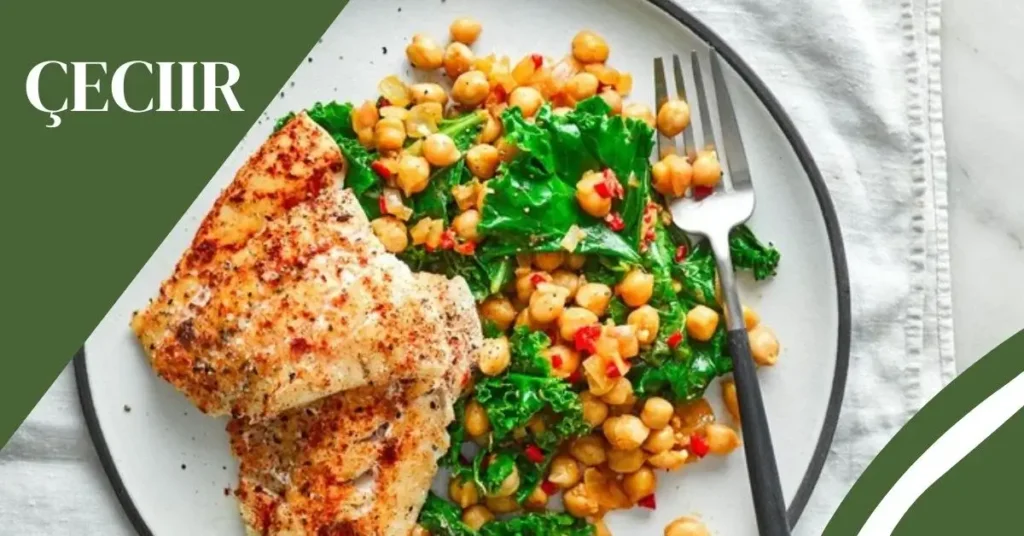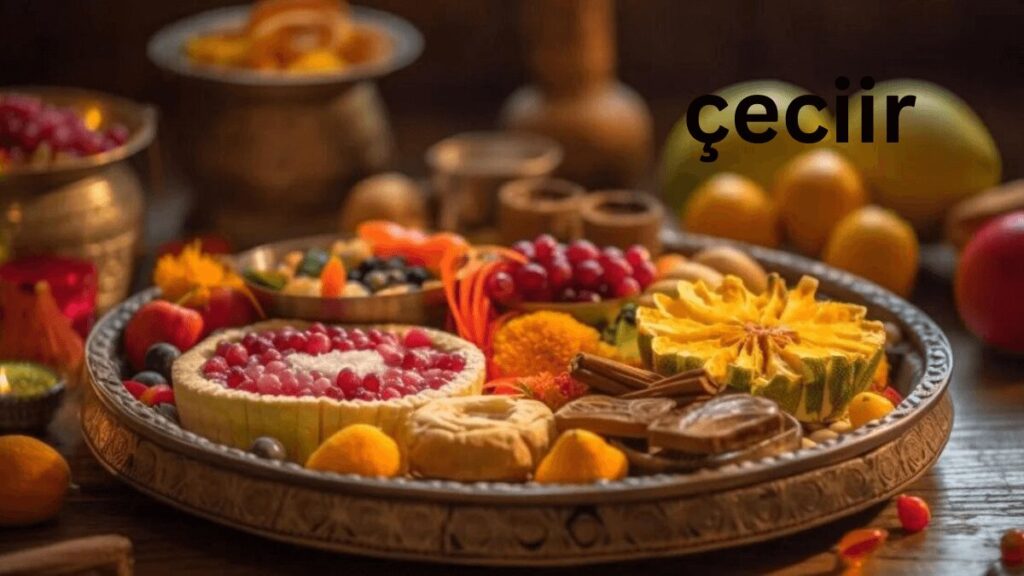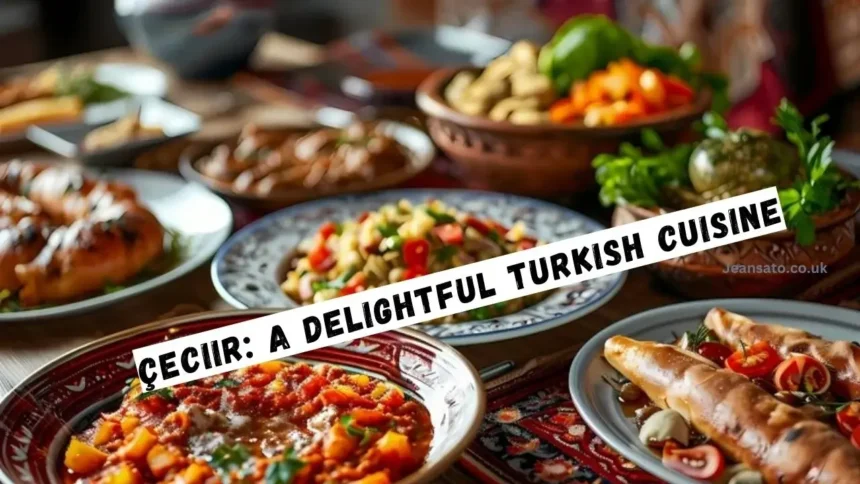Çeciir, a cultural culinary term, is part and parcel of Turkish culture, representing a combination of both culinary culture and social culture and personal experiences. First of all, çeciir is not only a type of dish being exchanged and shared among the people but also the unity of its people and history. Due to the historical backdrop and impact of different civilizations, this concept is an integral part of Turkish cuisine.
Through the investigation of çeciir, we find a universe where sharing meals, interpersonal exchange, and signification occur through food. Today, çeciir remains one of the specialties of the Turkic tribes who had wandered through the steppes, but at the same time, it reflects the brilliant taste of Ottoman cuisine.
Learn more about çeciir, how each dish is told as history, and how every meal is a moment of unity. Please proceed to the next page to learn more about the history of this practice, its main staples, and what this marvellous tradition means to various people.
What is Çeciir?
Çeciir is the sum of the cultural and social context of Turkish food and breakfast, symbolizing more than just a meal but an artistic touch. It emphasizes gathering for meal purposes and sitting together with one’s family and friends, which creates a feeling of oneness. The name of this type of bread comes from the original Turkish customs, and the recipes have also been inherited from generations, passing the authentic Turkish culinary history.
Such elements as the use of alcohol, inner-tribal rivalry over stunning women, and the dealing of irregular bribes have roots in çeciir connected with the past of nomadic Turkic tribes found in Central Asia. These tribes arrived at the new land with a blend of culinary traditions that had been adopted partly by the interaction with other cultures peculiarly, as people of Judeo-Arabic origin began settling in Anatolia, the formerly adopted influences harmonized with the local food culture and the resultant local cuisine that we today know as the çeciir.
Historical Context of Turkish Cuisine
The past of Turkish food and gastronomy is very colourful, and it consists of various civilizations and their impressions. The foundation was made by the nomadic Turkic tribes of Central Asia, which revealed the unique way of cooking, with further improvements throughout the centuries. When these tribes began to settle in Anatolia, they came across new agricultural products for the preparation of foods and new cookery practices enhancing their culinary style.
The Ottoman era was another critical point of Turkish cuisine development, and the empire’s appearance greatly influenced food. With the Ottomans, the ingredients and forms of cooking were already influenced by the Middle East, Balkans and Mediterranean regions. This integration of flares and cuisines can be observed in most of the foods and recipes that are found in Turkey today.
Signature Dishes of Çeciir
Kebabs: Turkish kebabs, such as Adana and Urfa, are famous worldwide. These skewered and grilled meats are seasoned with a combination of spices and often served with rice, bread, and fresh vegetables. The art of making kebabs has been perfected over centuries, with regional variations adding to their diversity.
Mezes: A staple of Turkish dining, mezes are small, delicious dishes served as appetizers or snacks. They include a variety of options such as hummus, baba ghanoush, dolmas (stuffed grape leaves), and sigara böreği (cheese-filled pastries). Mezes are designed for sharing, encouraging a communal dining experience.
Pide and Lahmacun: Often referred to as Turkish pizza, pide is a boat-shaped flatbread topped with cheese, meats, and vegetables. Lahmacun, on the other hand, is a thin, crispy flatbread completed with minced meat, tomatoes, onions, and herbs. Both dishes are popular street foods and are loved for their simplicity and flavour.
Baklava: This iconic Turkish dessert is made of layers of filo pastry served with chopped nuts and sweetened with honey or syrup. Baklava is a symbol of celebration and is often enjoyed during festivals and special occasions.
Manti: These tiny dumplings filled with spiced meat are traditionally served with a garlic yoghurt sauce and drizzled with melted butter and paprika. Manti is a beloved comfort food in Turkish cuisine, often prepared for family gatherings.

The Cultural Significance of Çeciir
Therefore, the issue of çeciir can be well defined from the food itself to the social relations associated with the food. Joints and big dishes remind people of the traditions and round table culture of the Turkish population, where meals are always served. Yet it is an honour for the Turk to be a guest and even more so if the guest is offered a meal.
Regional peculiarities also represent Turkish cuisine. Every area has its peculiarities and, therefore, there are differences in the types of sheds and cooking methods, which makes the food quite diverse. For instance, the Aegean region is famous for many olive oil dishes and sprouts, and the southeastern region of Turkey is renowned for its spicy kebabs and thick stews.
The Role of Spices in Çeciir
Turkish cuisine also considers spices to be a primary component that helps to create a rich and diverse taste of çeciir. Some of the common spices eaten with the foods include cumin, paprika, sumac, and mint, the spices used in preparing meats, vegetables, and grains, among others. Meat and rice dishes accompanied the dried fruits, nuts, and spices; in Turkish food, much care is taken to avoid overwhelming the palate with spices, although they are used to good effect to impart a pleasant fragrance to the dishes.
In addition to spices, herbs like parsley, dill, and mint are frequently used to garnish dishes, adding freshness and colour. The use of spices and herbs in Turkish cuisine reflects the influence of the Silk Road, which brought exotic flavours and ingredients to the region.
Regional Variations of Çeciir
Kebab can be funnelled back to Turkey’s regional differentiation leadership. Moreover, owing to the favourable climate and geographical condition of the country, there are many regional food divisions, and the dishes are different, too. The Aegean cuisine incorporates olive oil significantly, and meals that are prepared primarily include vegetables. There, in the southeastern part of Turkey, the food is considered to be richer and spicier, including such components as lamb, bulgur and chilli peppers.
The Black Seafoods include hams, which are fish, especially anchovies and karalahana, which is a black cabbage, among others. The internal Anatolia area insists on dishes made of steamed potatoes and stews and the most delicious pastries; Istanbul, as a unique mixture of all Turkish cultures, has exclusive Turkish meals to offer.
Cooking Techniques in Turkish Cuisine
Grilling, roasting, baking, and boiling are some of the cuisines used in Turkish cuisine. Kebabs are usually prepared on a stick over a direct fire, while stews and soups will be left to cook for a relatively long time to give them that rich, dark colour of slow-cooked foods. Cooking is also a significant procedure for dishes such as börek (stuffed pastries) and pide, which gives an idea of the professionalism of Turkish bakers.
Another significant method is fermentation, which helps in the making of yoghurt and pickles. These kinds of foods are tasty and increase the healthy characteristics of Turkish foods, which makes them more satisfying to consume.
See Also: Geöe: Your Ultimate Guide to Understanding Its Meaning
The Influence of Ottoman Cuisine
Indeed, the Turks influenced Ottoman cuisine by blending the richness of flavour and technology of cooking from all the Anatolian region and Europe, Asia, and African territories. Such royal kitchens as those of the sultans presupposed rich and elegant banquets that comprised a high number of dishes. Such past dishes like dolma, a preparation of stuffed vegetables, or sarma, which is grape leaves that are stuffed, are still prepared in modern Turkey.
It also recorded that, like other Ottoman cuisines, they incorporated the use of small portions of appetizers known as meze. Another significant element of çeciir is that this tradition of people eating together creates an atmosphere of togetherness and welcome.

Turkish Desserts and Sweets
Turkish sweets are generally lovely and fatty, and baklava is considered to be the most traditional sweet in Turkey. Filo pastry layered with nuts and drowned in syrup or honey, Baklawa is definitely one of the most traditional sweet treats and is loved during most joyful occasions. Other well-known sweets include:
- Künefe, a type of cheese pastry.
- Lokum, a gelatin-based confection.
- Helva is a confection made from sesame paste.
These desserts, more often than not, contain elements such as nuts, honey and rose water, which are prevalent in Middle Eastern and Mediterranean cuisine. Turkish desserts can undoubtedly be described as sophisticated due to the rich preparation and emphasis on the final appearance of the dishes.
Modern Influences on Çeciir
Still, Turkish cuisine retains a considerable amount of traditional elements and, at the same time, is open to trends of modernity. Modern cooks go for unheard-of ingredients and prepare different meals with the spirit of çeciir while maintaining modernity. The concept of old and new is also visible in trends like fusion cuisine, where traditional Turkish meals are prepared with the help of some other world cuisine trends.
Other influences include the result of new generations forming an opinion on food from different corners of the world, such as the farm-to-table and sustainable dieting trends, which have found their way into Turkey’s remodelled foods. Many of the çeciir restaurants are now paying particular attention to the choice of ingredients – taking fresh and locally sourced products and the methods of preparing them – with the emphasis placed on the traditional ones.
The Future of Çeciir
Looking into the future of çeciir is optimistic because there is even a growing demand for Turkish cuisine in Turkey and other countries. The number of Turkish restaurants and food products sold in Turkey is increasing day by day, which indicates the representation of various distinct and tasty çeciir recipes. Such international popularity is beneficial for the continuation of Turkish cuisine, as its original features are maintained now that the world is becoming more and more technologically advanced.
Now that Turkish cuisine has opened to popularity in the world, çeciir as a culinary tradition will also grow and change due to the rich and ever-developing nature of Turkish culture. Regardless of having been consumed in the classic oriental environment or provided in the frame of a contemporary restaurant, çeciir still puzzles together the legend of Turkish cuisine.
Conclusion
Çeciir, as one of the components of Turkish cuisine, is a synthesis of the peculiarities of the Turkish culinary culture at various stages of its evolution in terms of taste notes, traditions and customs. This is a true feast of flavours and aromas that let you discover the history of this magnificent country, Turkey. Whether you are eating a light Meze or having a sweet dessert of Baklava or Kadayif, Turkish cuisine offers you an atmosphere and the essence of çeciir – warm Turkish hospitality.
FAQs
What is the origin of çeciir?
Çeciir originates from the nomadic Turkic tribes of Central Asia and has evolved through centuries of cultural exchanges and historical events.
What are some popular dishes in çeciir?
Popular dishes include kebabs, mezes, pide, lahmacun, baklava, and manti.
How does çeciir reflect Turkish culture?
Çeciir embodies the communal and familial dining experiences that are central to Turkish culture, emphasizing hospitality and togetherness.
What role do spices play in Turkish cuisine?
Spices like cumin, paprika, and mint are crucial in adding depth and complexity to Turkish dishes, reflecting the influence of the Silk Road.
How has modern cuisine influenced çeciir?
Modern influences have introduced new ingredients and techniques, creating innovative dishes that retain the essence of çeciir while offering a fresh perspective.









